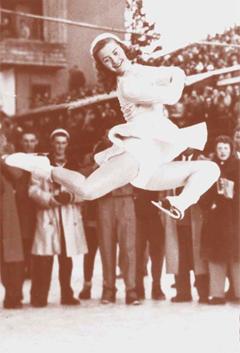Barbara Ann Scott
As Good As Gold
After Barbara Ann Scott won Gold in 1948
at the European, Olympic, and World Figure Skating Championships, the Ottawa
born (1928) skater told the press, " I want to get married and live in
a house with a white picket fence. " This prompted the New York Daily News
to headline its story, " Great Scott - She'd Rather Cook." The article,
that followed however, described her accomplishment in glowing terms: "
Beauteous Barbara Ann Scott, Canada's sparkling ballerina on the ice, won
the women's figure skating championships ... before 7,000 dazzled admirers
who hailed her performance as superior to Sonja Henie's best as an amatuer."
That was only one
of the lavish descriptions accorded Barbara Ann from the moment she won
the European and World Championship a year earlier. On that occasion she
returned home to a tumultuous welcome in Ottawa. Children were let out
of school, a 32-piece band struck up "Let Me Call You Sweetheart," and
the Mayor presented her with a new car and the freedom of the city.

|
| As
European, World, and Olympic Champion, Barbara Ann Scott returned home
to Ottawa in 1948 to face exuberant crowds exceeding 70,000 admirers. She
was grateful upon being given the key to the city and a brand new convertible.
[Photo, courtesy Charles J. Humber Collection] |
The car, however,
caused controversy because a fusty Avery Brundage, President of the American
Olympic Association and President-elect of the International Olympic Committee,
thundered that accepting the vehicle made her ineligible to compete in
the 1948 Winter Olympics taking place the next year in Switzerland. Barbara
Ann tearfully returned the car and spent the rest of that winter performing
at local charity carnivals and exhibitions besides practising eight hours
a day to prepare for the three major championships of 1948: defence of
both her European and World crowns, in addition to her quest for Olympic
gold!
Some felt she should
skip the European title being held at Prague, but her coach, Sheldon Galbraith,
who described her as "a perfectionist with phenomenal balance," believed
she could outskate not only all of the other women competitors but most
of the men as well.
He proved correct.
Before 12,000 Czech admirers, she earned the highest marks ever given to
a figure skater in that country. Moving on to the Olympics at St. Moritz,
Barbara Ann was greeted by warm weather that delayed the start of the ice
skating competitions and added to the overall tension. The ice was still
poor three days later when 25 women from seven countries competed in the
compulsory figures. Barbara Ann won with 858.1 points.
The next day the
ice was even worse as a result of two hockey games played that morn-ing,
but Barbara Ann's coach realized that during the games, when the boards
for hockey were removed, a narrow strip of clear ice was left. They quickly
worked out a variation of her planned four-minute program. She did one
double loop instead of three at the beginning and ended with three double
salchows instead of the double loops she had intended. A standing ovation
followed and, though there were 12 other skaters to follow, few doubted
she had won. And she did, scoring 166.077 points for the gold medal.
When standing on
the podium the next day, she fondly remembered her father and "felt happy,
sad and proud all at the same time." Her late father, a former army colonel
and senior civil servant, had been the first to encourage her to skate.
Her mother had been equally encouraging. At age nine, Barbara Ann trained
seven hours daily while being tutored at home in school subjects. At 10
she became the youngest Canadian ever to win a national gold medal. She
was Canadian senior women's champion between 1944 and 1948, North American
champion 1945-48, and won the European and World titles in 1947. But her
dream came true with the 1948 Olympic gold medal.
 |
When
Barbara Ann Scott won gold at the European, World, and Olympic Championships
– all within six weeks – Canada's love affair with the blonde charmer blossomed
into adoration. Her dazzling performances generated celebrity status for
the first Canadian female skater ever to capture gold at the Olympics.
[Photo, courtesy National Archives of Canada/PA-49893] |
Two weeks later,
at the age of twenty, she again captured the World Championship at Davos,
Switzerland, and returned home to a thunderous welcome of 70,000 well-wishers.
There was added pressure when she turned professional. This time, however,
she was represented with a convertible with a personalized licence plate
reading 48-VI, signifying her triumph at the 1948 sixth Winter Olympics.
Her professional contract stipulated that a percentage of all her future
earnings be given to aid crippled children.
Barbara Ann, however,
did not enjoy the experience of living out of a suitcase or skating on
smaller ice surfaces (in Hollywood a 30' by 40' tank and in Chicago, 20'
by 24'), or audiences unable to appreciate the finer points of her figure
skating abilities. Nevertheless, she carried on for a five-year stint with
ice shows before quitting to marry, in 1955, Tom King, the publicity director
of the revue in which she was the star. They settled near Chicago where
her white picket fence became a white post corral as she turned her attention
to raising show horses and became one of the top-rated equestriennes in
the USA.
Mel James